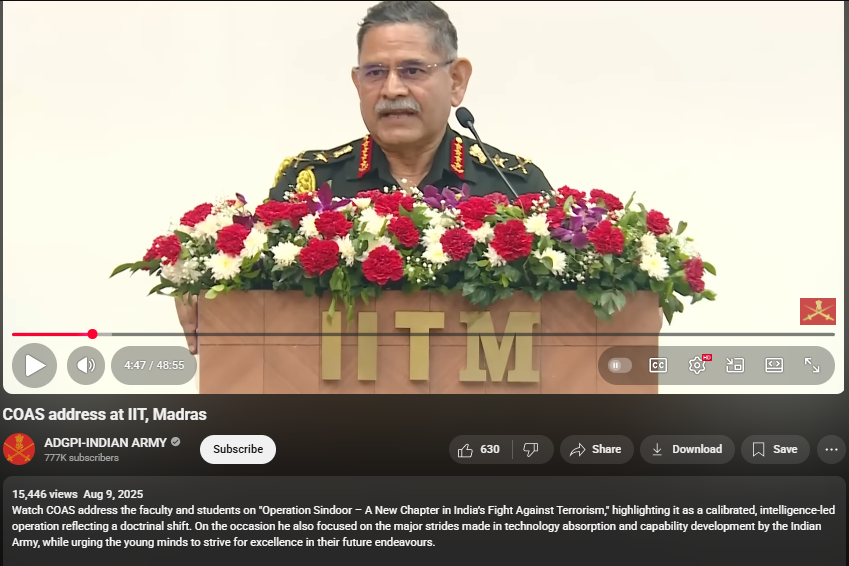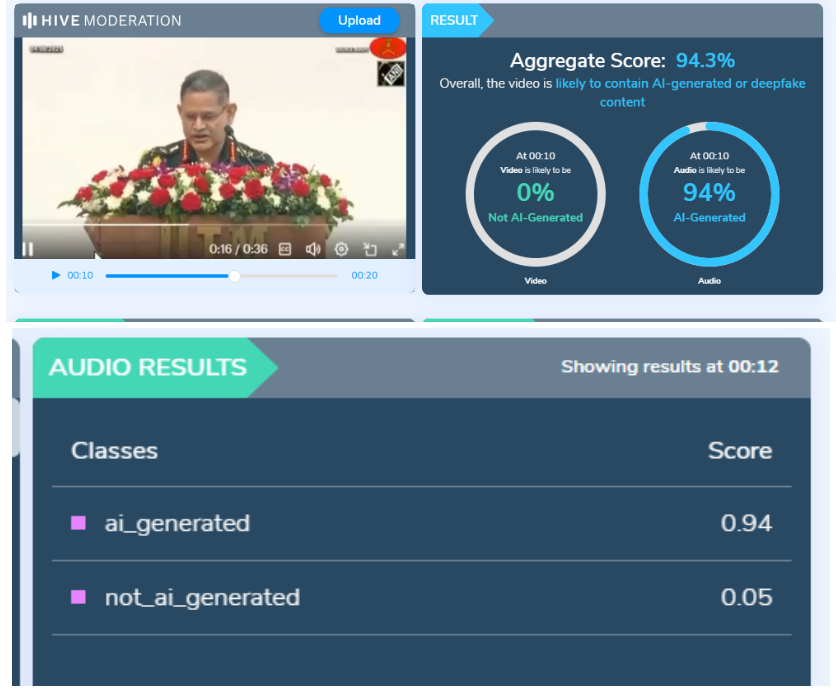#FactCheck: AI-Generated Audio Falsely Claims COAS Admitted to Loss of 6 Jets and 250 Soldiers
Executive Summary:
A viral video (archive link) claims General Upendra Dwivedi, Chief of Army Staff (COAS), admitted to losing six Air Force jets and 250 soldiers during clashes with Pakistan. Verification revealed the footage is from an IIT Madras speech, with no such statement made. AI detection confirmed parts of the audio were artificially generated.
Claim:
The claim in question is that General Upendra Dwivedi, Chief of Army Staff (COAS), admitted to losing six Indian Air Force jets and 250 soldiers during recent clashes with Pakistan.

Fact Check:
Upon conducting a reverse image search on key frames from the video, it was found that the original footage is from IIT Madras, where the Chief of Army Staff (COAS) was delivering a speech. The video is available on the official YouTube channel of ADGPI – Indian Army, published on 9 August 2025, with the description:
“Watch COAS address the faculty and students on ‘Operation Sindoor – A New Chapter in India’s Fight Against Terrorism,’ highlighting it as a calibrated, intelligence-led operation reflecting a doctrinal shift. On the occasion, he also focused on the major strides made in technology absorption and capability development by the Indian Army, while urging young minds to strive for excellence in their future endeavours.”
A review of the full speech revealed no reference to the destruction of six jets or the loss of 250 Army personnel. This indicates that the circulating claim is not supported by the original source and may contribute to the spread of misinformation.

Further using AI Detection tools like Hive Moderation we found that the voice is AI generated in between the lines.

Conclusion:
The claim is baseless. The video is a manipulated creation that combines genuine footage of General Dwivedi’s IIT Madras address with AI-generated audio to fabricate a false narrative. No credible source corroborates the alleged military losses.
- Claim: AI-Generated Audio Falsely Claims COAS Admitted to Loss of 6 Jets and 250 Soldiers
- Claimed On: Social Media
- Fact Check: False and Misleading
Related Blogs

Brief Overview of the EU AI Act
The EU AI Act, Regulation (EU) 2024/1689, was officially published in the EU Official Journal on 12 July 2024. This landmark legislation on Artificial Intelligence (AI) will come into force just 20 days after publication, setting harmonized rules across the EU. It amends key regulations and directives to ensure a robust framework for AI technologies. The AI Act, a set of EU rules governing AI, has been in development for two years and now, the EU AI Act enters into force across all 27 EU Member States on 1 August 2024, with certain future deadlines tied up and the enforcement of the majority of its provisions will commence on 2 August 2026. The law prohibits certain uses of AI tools, including those that threaten citizens' rights, such as biometric categorization, untargeted scraping of faces, and systems that try to read emotions are banned in the workplace and schools, as are social scoring systems. It also prohibits the use of predictive policing tools in some instances. The law takes a phased approach to implementing the EU's AI rulebook, meaning there are various deadlines between now and then as different legal provisions will start to apply.
The framework puts different obligations on AI developers, depending on use cases and perceived risk. The bulk of AI uses will not be regulated as they are considered low-risk, but a small number of potential AI use cases are banned under the law. High-risk use cases, such as biometric uses of AI or AI used in law enforcement, employment, education, and critical infrastructure, are allowed under the law but developers of such apps face obligations in areas like data quality and anti-bias considerations. A third risk tier also applies some lighter transparency requirements for makers of tools like AI chatbots.
In case of failure to comply with the Act, the companies in the EU providing, distributing, importing, and using AI systems and GPAI models, are subject to fines of up to EUR 35 million or seven per cent of the total worldwide annual turnover, whichever is higher.
Key highlights of EU AI Act Provisions
- The AI Act classifies AI according to its risk. It prohibits Unacceptable risks such as social scoring systems and manipulative AI. The regulation mostly addresses high-risk AI systems.
- Limited-risk AI systems are subject to lighter transparency obligations and according to the act, the developers and deployers must ensure that the end-users are aware that the interaction they are having is with AI such as Chatbots and Deepfakes. The AI Act allows the free use of minimal-risk AI. This includes the majority of AI applications currently available in the EU single market like AI-enabled video games, and spam filters, but with the advancement of Gen AI changes with regards to this might be done. The majority of obligations fall on providers (developers) of high-risk AI systems that intend to place on the market or put into service high-risk AI systems in the EU, regardless of whether they are based in the EU or a third country. And also, a third-country provider where the high-risk AI system’s output is used in the EU.
- Users are natural or legal persons who deploy an AI system in a professional capacity, not affected end-users. Users (deployers) of high-risk AI systems have some obligations, though less than providers (developers). This applies to users located in the EU, and third-country users where the AI system’s output is used in the EU.
- General purpose AI or GPAI model providers must provide technical documentation, and instructions for use, comply with the Copyright Directive, and publish a summary of the content used for training. Free and open license GPAI model providers only need to comply with copyright and publish the training data summary, unless they present a systemic risk. All providers of GPAI models that present a systemic risk – open or closed – must also conduct model evaluations, and adversarial testing, and track and report serious incidents and ensure cybersecurity protections.
- The Codes of Practice will account for international approaches. It will cover but not necessarily be limited to the obligations, particularly the relevant information to include in technical documentation for authorities and downstream providers, identification of the type and nature of systemic risks and their sources, and the modalities of risk management accounting for specific challenges in addressing risks due to the way they may emerge and materialize throughout the value chain. The AI Office may invite GPAI model providers, and relevant national competent authorities to participate in drawing up the codes, while civil society, industry, academia, downstream providers and independent experts may support the process.
Application & Timeline of Act
The EU AI Act will be fully applicable 24 months after entry into force, but some parts will be applicable sooner, for instance the ban on AI systems posing unacceptable risks will apply six months after the entry into force. The Codes of Practice will apply nine months after entry into force. Rules on general-purpose AI systems that need to comply with transparency requirements will apply 12 months after the entry into force. High-risk systems will have more time to comply with the requirements as the obligations concerning them will become applicable 36 months after the entry into force. The expected timeline for the same is:
- August 1st, 2024: The AI Act will enter into force.
- February 2025: Prohibition of certain AI systems - Chapters I (general provisions) & II (prohibited AI systems) will apply; Prohibition of certain AI systems.
- August 2025: Chapter III Section 4 (notifying authorities), Chapter V (general purpose AI models), Chapter VII (governance), Chapter XII (confidentiality and penalties), and Article 78 (confidentiality) will apply, except for Article 101 (fines for General Purpose AI providers); Requirements for new GPAI models.
- August 2026: The whole AI Act applies, except for Article 6(1) & corresponding obligations (one of the categories of high-risk AI systems);
- August 2027: Article 6(1) & corresponding obligations apply.
The AI Act sets out clear definitions for the different actors involved in AI, such as the providers, deployers, importers, distributors, and product manufacturers. This means all parties involved in the development, usage, import, distribution, or manufacturing of AI systems will be held accountable. Along with this, the AI Act also applies to providers and deployers of AI systems located outside of the EU, e.g., in Switzerland, if output produced by the system is intended to be used in the EU. The Act applies to any AI system within the EU that is on the market, in service, or in use, covering both AI providers (the companies selling AI systems) and AI deployers (the organizations using those systems).
In short, the AI Act will apply to different companies across the AI distribution chain, including providers, deployers, importers, and distributors (collectively referred to as “Operators”). The EU AI Act also has extraterritorial application and can also apply to companies not established in the EU, or providers outside the EU if they -make an AI system or GPAI model available on the EU market. Even if only the output generated by the AI system is used in the EU, the Act still applies to such providers and deployers.
CyberPeace Outlook
The EU AI Act, approved by EU lawmakers in 2024, is a landmark legislation designed to protect citizens' health, safety, and fundamental rights from potential harm caused by AI systems. The AI Act will apply to AI systems and GPAI models. The Act creates a tiered risk categorization system with various regulations and stiff penalties for noncompliance. The Act adopts a risk-based approach to AI governance, categorizing potential risks into four tiers: unacceptable, high, limited, and low. Violations of banned systems carry the highest fine: €35 million, or 7 percent of global annual revenue. It establishes transparency requirements for general-purpose AI systems. The regulation also provides specific rules for general-purpose AI (GPAI) models and lays down more stringent requirements for GPAI models with 'high-impact capabilities' that could pose a systemic risk and have a significant impact on the internal market. For high-risk AI systems, the AI Act addresses the issues of fundamental rights impact assessment and data protection impact assessment.
The EU AI Act aims to enhance trust in AI technologies by establishing clear regulatory standards governing AI. We encourage regulatory frameworks that strive to balance the desire to foster innovation with the critical need to prevent unethical practices that may cause user harm. The legislation can be seen as strengthening the EU's position as a global leader in AI innovation and developing regulatory frameworks for emerging technologies. It sets a global benchmark for regulating AI. The companies to which the act applies will need to make sure their practices align with the same. The act may inspire other nations to develop their own legislation contributing to global AI governance. The world of AI is complex and challenging, the implementation of regulatory checks, and compliance by the concerned companies, all pose a conundrum. However, in the end, balancing innovation with ethical considerations is paramount.
At the same hand, the tech sector welcomes regulatory progress but warns that overly-rigid regulations could stifle innovation. Hence flexibility and adaptability are key to effective AI governance. The journey towards robust AI regulation has begun in major countries, and it is important that we find the right balance between safety and innovation and also take into consideration the industry reactions.
References:
- https://eur-lex.europa.eu/legal-content/EN/TXT/PDF/?uri=OJ:L_202401689
- https://www.theverge.com/2024/7/12/24197058/eu-ai-act-regulations-bans-deadline
- https://techcrunch.com/2024/07/12/eus-ai-act-gets-published-in-blocs-official-journal-starting-clock-on-legal-deadlines/
- https://www.wsgr.com/en/insights/eu-ai-act-to-enter-into-force-in-august.html
- https://www.techtarget.com/searchenterpriseai/tip/Is-your-business-ready-for-the-EU-AI-Act
- https://www.simmons-simmons.com/en/publications/clyimpowh000ouxgkw1oidakk/the-eu-ai-act-a-quick-guide

Introduction
Public infrastructure has traditionally served as the framework for civilisation, transporting people, money, and ideas across time and space, from the iron veins of transcontinental railroads to the unseen arteries of the internet. In democracies where free markets and public infrastructure co-exist, this framework has not only facilitated but also accelerated progress. Digital Public Infrastructure (DPI), which powers inclusiveness, fosters innovation, and changes citizens from passive recipients to active participants in the digital age, is emerging as the new civic backbone as we move away from highways and towards high-speed data.
DPI makes it possible for innovation at the margins and for inclusion at scale by providing open-source, interoperable platforms for identities, payments, and data exchange. Examples of how the Global South is evolving from a passive consumer of technology to a creator of globally replicable governance models are India’s Aadhaar (digital identification), UPI (real-time payments), and DigiLocker (data empowerment). As the ‘digital commons’ emerges, DPI does more than simply link users; it also empowers citizens, eliminates inefficiencies from the past, and reimagines the creation and distribution of public value in the digital era.
Securing the Digital Infrastructure: A Contemporary Imperative
As humans, we are already the inhabitants of the future, we stand at the temporal threshold for reform. Digital Infrastructure is no longer just a public good. It’s now a strategic asset, akin to oil pipelines in the 20th century. India is recognised globally for the introduction of “India Stack”, through which the face of digital payments has also been changed. The economic value contributed by DPIs to India’s GDP is predicted to reach 2.9-4.2 percent by 2030, having already reached 0.9% in 2022. Its role in India’s economic development is partly responsible for its success; among emerging market economies, it helped propel India to the top of the revenue administrations’ digitalisation index. The other portion has to do with how India’s social service delivery has changed across the board. By enabling digital and financial inclusion, it has increased access to education (DIKSHA) and is presently being developed to offer agricultural (VISTAAR) and digital health (ABDM) services.
Securing the Foundations: Emerging Threats to Digital Public Infrastructure
The rising prominence of DPI is not without its risks, as adversarial forces are developing with comparable sophistication. The core underpinnings of public digital systems are the target of a new generation of cyber threats, ranging from hostile state actors to cybercriminal syndicates. The threats pose a great risk to the consistent development endeavours of the government. To elucidate, targeted attacks on Biometric databases, AI-based Misinformation and Psychological Warfare, Payment System Hacks, State-sponsored malware, cross-border phishing campaigns, surveillance spyware and Sovereign Malware are modern-day examples of cyber threats.
To secure DPI, a radical rethink beyond encryption methods and perimeter firewalls is needed. It requires an understanding of cybersecurity that is systemic, ethical, and geopolitical. Democracy, inclusivity, and national integrity are all at risk from DPI. To preserve the confidence and promise of digital public infrastructure, policy frameworks must change from fragmented responses to coordinated, proactive and people-centred cyber defence policies.
CyberPeace Recommendations
Powering Progress, Ignoring Protection: A Precarious Path
The Indian government is aware that cyberattacks are becoming more frequent and sophisticated in the nation. To address the nation’s cybersecurity issues, the government has implemented a number of legislative, technical, and administrative policy initiatives. While the initiatives are commendable, there are a few Non-Negotiables that need to be in place for effective protection:
- DPIs must be declared Critical Information Infrastructure. In accordance with the IT Act, 2000, the DPI (Aadhaar, UPI, DigiLocker, Account Aggregator, CoWIN, and ONDC) must be designated as Critical Information Infrastructure (CII) and be supervised by the NCIIPC, just like the banking, energy, and telecom industries. Give NCIIPC the authority to publish required security guidelines, carry out audits, and enforce adherence to the DPI stack, including incident response protocols tailored to each DPI.
- To solidify security, data sovereignty, and cyber responsibility, India should spearhead global efforts to create a Global DPI Cyber Compact through the “One Future Alliance” and the G20. To ensure interoperable cybersecurity frameworks for international DPI projects, promote open standards, cross-border collaboration on threat intelligence, and uniform incident reporting guidelines.
- Establish a DPI Threat Index to monitor vulnerabilities, including phishing attacks, efforts at biometric breaches, sovereign malware footprints, spikes in AI misinformation, and patterns in payment fraud. Create daily or weekly risk dashboards by integrating data from state CERTs, RBI, UIDAI, CERT-In, and NPCI. Use machine learning (ML) driven detection systems.
- Make explainability audits necessary for AI/ML systems used throughout DPI to make sure that the decision-making process is open, impartial, and subject to scrutiny (e.g., welfare algorithms, credit scoring). Use the recently established IndiaAI Safety Institute in line with India’s AI mission to conduct AI audits, establish explanatory standards, and create sector-specific compliance guidelines.
References
- https://orfamerica.org/newresearch/dpi-catalyst-private-sector-innovation?utm_source=chatgpt.com
- https://www.institutmontaigne.org/en/expressions/indias-digital-public-infrastructure-success-story-world
- https://www.pib.gov.in/PressReleasePage.aspx?PRID=2116341
- https://www.pib.gov.in/PressReleaseIframePage.aspx?PRID=2033389
- https://www.governancenow.com/news/regular-story/dpi-must-ensure-data-privacy-cyber-security-citizenfirst-approach

Executive Summary:
In the context of the recent earthquake in Taiwan, a video has gone viral and is being spread on social media claiming that the video was taken during the recent earthquake that occurred in Taiwan. However, fact checking reveals it to be an old video. The video is from September 2022, when Taiwan had another earthquake of magnitude 7.2. It is clear that the reversed image search and comparison with old videos has established the fact that the viral video is from the 2022 earthquake and not the recent 2024-event. Several news outlets had covered the 2022 incident, mentioning additional confirmation of the video's origin.

Claims:
There is a news circulating on social media about the earthquake in Taiwan and Japan recently. There is a post on “X” stating that,
“BREAKING NEWS :
Horrific #earthquake of 7.4 magnitude hit #Taiwan and #Japan. There is an alert that #Tsunami might hit them soon”.

Similar Posts:


Fact Check:
We started our investigation by watching the videos thoroughly. We divided the video into frames. Subsequently, we performed reverse search on the images and it took us to an X (formally Twitter) post where a user posted the same viral video on Sept 18, 2022. Worth to notice, the post has the caption-
“#Tsunami warnings issued after Taiwan quake. #Taiwan #Earthquake #TaiwanEarthquake”

The same viral video was posted on several news media in September 2022.

The viral video was also shared on September 18, 2022 on NDTV News channel as shown below.

Conclusion:
To conclude, the viral video that claims to depict the 2024 Taiwan earthquake was from September 2022. In the course of the rigorous inspection of the old proof and the new evidence, it has become clear that the video does not refer to the recent earthquake that took place as stated. Hence, the recent viral video is misleading . It is important to validate the information before sharing it on social media to prevent the spread of misinformation.
Claim: Video circulating on social media captures the recent 2024 earthquake in Taiwan.
Claimed on: X, Facebook, YouTube
Fact Check: Fake & Misleading, the video actually refers to an incident from 2022.


